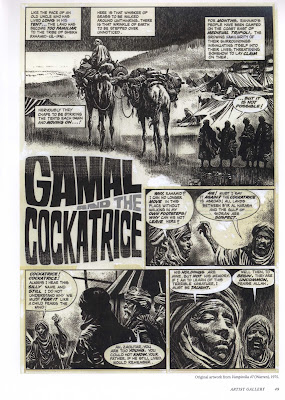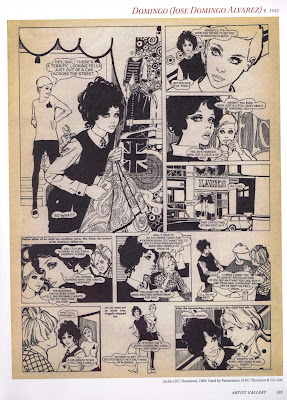by David Roach
Dynamite, April 2017
This book originally was scheduled to be published in January of 2017, but it actuality it didn't come out on store shelves until April.
So, how does the book present ?
Overall, it's pretty good.
The opening chapters of the book provide a chronological overview of the work of Spanish artists in the comic book, magazine, paperback book cover, commercial art, and fine art realms of Europe and the U.S. from the early 1900s to the 1980s.
Author Roach (who comes by his expertise in the Warren magazines and Spanish comic art legitimately, as the author of The Warren Companion, 2001, and The Art of Jose Gonzalez, 2015) does a good job of informing readers that the memorable work done by Spanish artists for Warren, Marvel, Skywald, and other U.S. publishers in the 70s and early 80s was only a part of the tremendous amount of art furnished by artists at such Spanish agencies as Selecciones Illustradas, Bruguera, and Bardon.
The abundance of talented graphic artists in Spain meant that the Spanish commercial art market couldn't accommodate all of them, so many of the artists profiled in the book first began working for English publishers in the 50s and 60s, on romance and war titles. The adaptability of the Spanish artists meant that, after the end of the Warren magazines in 1983, many readily found work in providing cover and interior art for a host of German and Italian publications, such as the hugely popular Western series Tex.
The introductory chapters are followed by the artist profiles, which take up the bulk of the book. Major figures in the field, such as Rafael Aura Leon (aka 'Auraleon'), Jordi Bernet, Victor de la Fuente, Jose Gonzalez, Esteban Maroto, and Felix Mas all get several pages, while other artists may have one or two pages.
The book closes with a chapter, 'A New Generation', that looks at the work of a newer generation of Spanish artists, including Ruben Pellejero, Daniel Torres, David Rubin and Ana Miralles, many of whom work for major U.S. and French comic book publishers on a variety of titles.
You can find reviews at amazon about Dynamite's lineup of hardcover comic art books, particularly its Vampirella compilations, which criticize these volumes for poor color, or black and white, reproductions, as well as the omission of pages from the original art. While Masters of Spanish Comic Book Art doesn't reproduce any comics in their entirety, and so the 'missing pages' complaint is moot, I can say that Masters has very good color reproductions, printed on quality stock paper.
One area, however, where the book does fall short is in the large number of typos; while I can overlook a few here and there, the typos in Masters often are a distraction. I don't know where in the production process these creeped in, but it speaks to a need for better proofreading.
One thing Masters of Spanish Comic Book Art succeeds in doing, is sparking interest in the large body of work that has yet to be translated into English and showcased for an American audience.
For example, throughout the early 80s, the Spanish magazine (revista) Cimoc, which could be considered the equivalent of Heavy Metal, printed some outstanding work by many of the artists profiled in the book.
Whether the content of these revistas ever will be formatted for an English-speaking readership is uncertain, as no collections in Spanish, equivalent to the 'Archives' volumes published for the Warren titles, have (to the best of my knowledge) ever been released.
Summing up, Masters of Spanish Comic Book Art certainly stands out as a great overview of a topic of interest to anyone who likes comic book and graphic art, the American black and white horror magazines of the 70s, Heavy Metal / Metal Hurlant, and the large body of comic art presented in publications in the UK and Western Europe. These fans will find the book to be a worthy reference, an entertaining read, and in many instances a nostalgia trip.
It's less clear whether anyone under the age of 40 will find the book a must-have. As author Roach points out in the book's last chapter, 'A New Generation', few if any Spanish artists still use the highly textured, pencil- centered approach to comic art that marked the generation that contributed to the American magazines of the 70s.
With no black-and-white magazines such as Creepy or Vampirella on the stands anyone, and most contemporary comic book content rendered in computer-assisted color, most modern readers of comic books have little, if any, familiarity with the illustrative styles that dominated comic book publishing over forty years ago. However, those younger readers who do elect to peruse the pages of Masters of Spanish Comic Book Art are sure to find material here worth their attention.









































1 comment:
hi, I'm Francisco from Spain, Tarbandu can you email me zalman1972@live.com I've got some doubts and questions for you
thanks in advance
Post a Comment